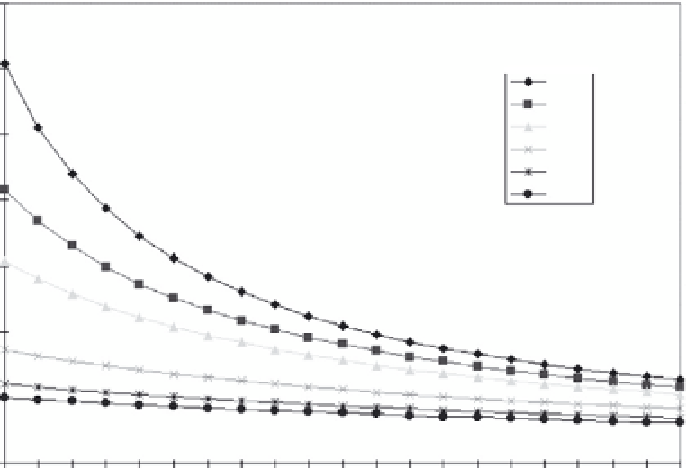Biomedical Engineering Reference
In-Depth Information
rate is the excess energy required for pyrolysis, which, as discussed before, manifests itself
as a higher ablation threshold temperature.
Although the full solution of the ablation problem in this chapter was not considered, in
order to understand how these phenomena affect the ablation rate, the steady-state ablation
velocity may be used. This equation can be directly derived to be
I
v
ss
¼
f
L
L
:
ð
17
:
83
Þ
r
c
D
T
ab
þ
r
v
ss
can be
determined. In the following example, the physical properties of water are used, and
Fixing the values of
I
, r,
c
, and
L
, the effect of the parameters
f
L
and
D
T
ab
on
I
is
100
o
C and
chosen to be 267.8 W/cm2 so
1. Figure 17.18
shows the effect of ablation temperature on the ablation velocity for various values of
f
L
v
ss
¼
1mm/sec for
D
T
ab
¼
f
L
¼
f
L
is a decrease in ablation velocity as is also obvious from Eq. (17.83). Observe, however, that
the larger the value of
from 0.01 to 1.0. The general effect of an increase either in ablation temperature or in
, the less effect the ablation temperature has on the ablation veloc-
ity. For instance, whereas for
f
L
0.1 ablation, velocity drops from 4 mm/sec to 1.15 mm/
sec over a temperature change from 100
o
C to 500
o
C for the same range, and for
f
L
¼
f
L
¼
0.8, the
change is only from 1.20 mm/sec to 0.69 mm/sec. Therefore, if
should indicate the
fraction of water in tissue, for example, a decrease in ablation rate should be of concern
as a result of higher pyrolysis/ablation temperatures only for tissue with “low” water
content (e.g., 30 percent or lower).
A cross section of families of curves in Figure 17.18 at
f
L
200
o
C for more values of
D
T
ab
¼
f
L
is shown in Figure 17.19.
This figure shows that a change of
200
o
C results in a change in
the ablation velocity from 3.2 mm/sec to 0.86 mm/sec; that is, the ablation velocity can be
f
L
from 0 to 1 for
D
T
ab
¼
1
6
f
L
=0.01
f
L
=0.1
f
L
=0.2
f
L
=0.5
f
L
=0.8
f
L
=0.0
5
4
3
2
1
0
Ablation Temperature (C)
FIGURE 17.18
Effect of ablation temperature on ablation velocity for various water contents.






